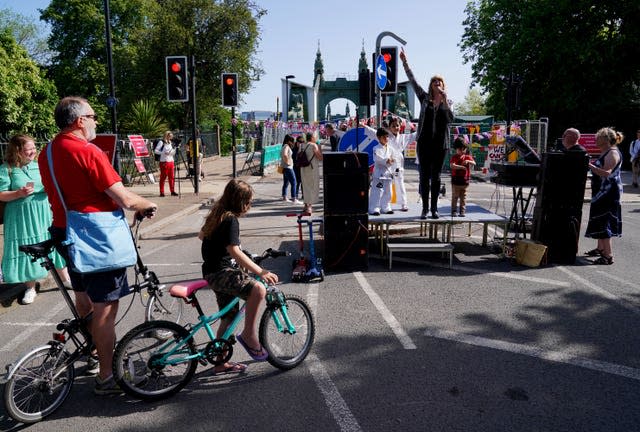Cyclists and pedestrians return to Hammersmith Bridge
Cyclists and pedestrians have begun using west London’s Hammersmith Bridge again after safety checks allowed it to partially reopen this weekend.
The 134-year-old cast-iron structure was closed to all users in August last year after cracks in the pedestals deteriorated further during a heatwave.
On a sunny Saturday morning, cyclists young and old were out on the bridge, some crossing back and forth several times.
Joggers and walkers were also using the River Thames crossing as local residents celebrated its partial reopening.
At its southern end, one woman sang from a mini stage erected in the middle of the road.
A crew of rowers glided under the bridge, with vessels on the river now allowed to pass beneath it.

The pedestal cracks led to motor vehicles being prohibited from using the bridge in April 2019, with the August 2020 heatwave leading to it being shut off to all users.
The closure increased journey times and congestion as people took alternative routes across the Thames.
A ban on river traffic was also a key factor in the annual University Boat Race being moved to Ely, Cambridgeshire.
But after passing safety checks, Hammersmith and Fulham Council said pedestrians and cyclists would be permitted to return to the crossing.

The council has installed a £420,000 temperature control system to help prevent cracking in the pedestals.
Acoustic sensors have also been fitted to identify further cracks.
The board for the Case for the Continued Safe Operation of the bridge (CCSO), which is advising the council, said these measures combined with engineering inspections mean the safety risk of allowing pedestrians and cyclists to use the crossing is “acceptably low”.
It said that the “temporary measures” were “not a substitute for permanent repair”, adding: “Without a funded plan for repair the limited current use must cease eventually.”
The Department for Transport said last month that the Government will not contribute more than a third of the repair costs of the bridge, which are estimated to exceed £100 million.


